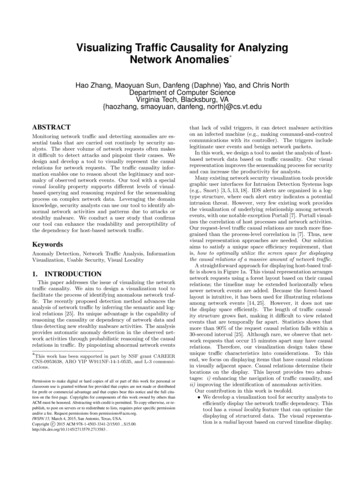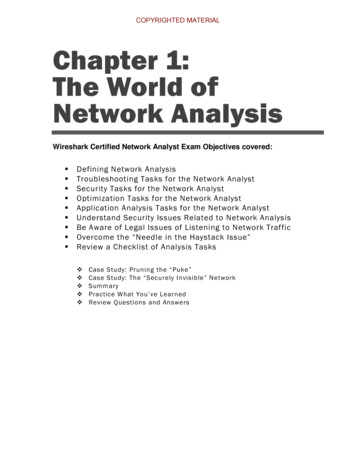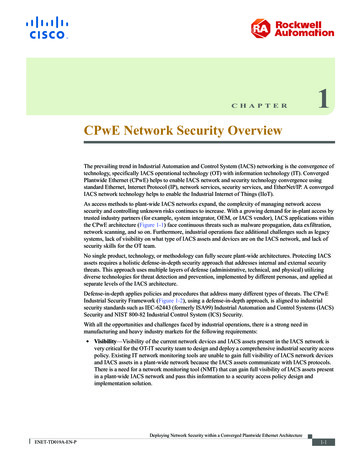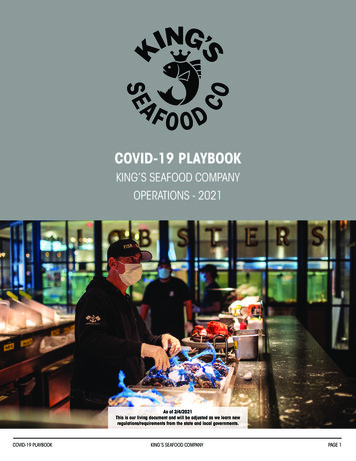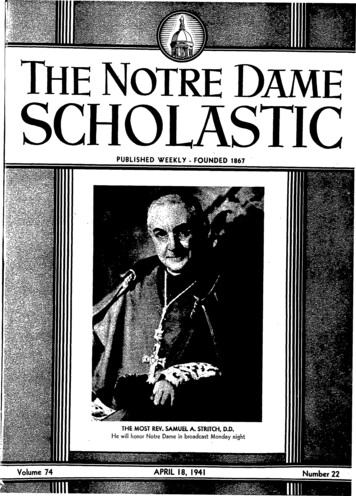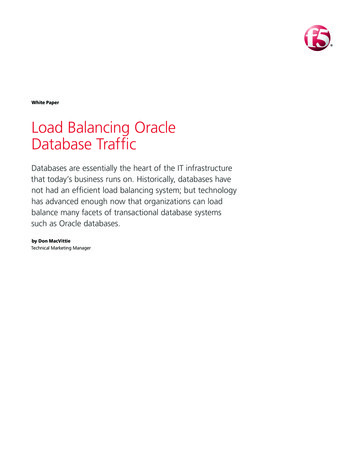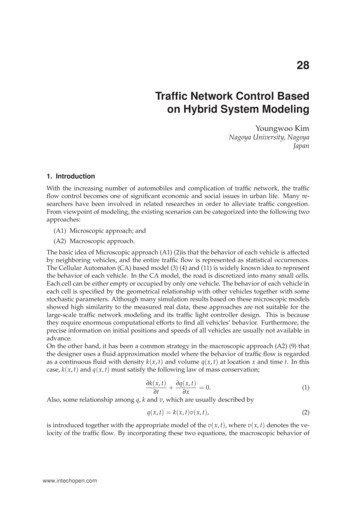
Transcription
0Traffic Network Control Basedon Hybrid System ModelingYoungwoo KimNagoya University, NagoyaJapan1. IntroductionWith the increasing number of automobiles and complication of traffic network, the trafficflow control becomes one of significant economic and social issues in urban life. Many researchers have been involved in related researches in order to alleviate traffic congestion.From viewpoint of modeling, the existing scenarios can be categorized into the following twoapproaches:(A1) Microscopic approach; and(A2) Macroscopic approach.The basic idea of Microscopic approach (A1) (2)is that the behavior of each vehicle is affectedby neighboring vehicles, and the entire traffic flow is represented as statistical occurrences.The Cellular Automaton (CA) based model (3) (4) and (11) is widely known idea to representthe behavior of each vehicle. In the CA model, the road is discretized into many small cells.Each cell can be either empty or occupied by only one vehicle. The behavior of each vehicle ineach cell is specified by the geometrical relationship with other vehicles together with somestochastic parameters. Although many simulation results based on these microscopic modelsshowed high similarity to the measured real data, these approaches are not suitable for thelarge-scale traffic network modeling and its traffic light controller design. This is becausethey require enormous computational efforts to find all vehicles’ behavior. Furthermore, theprecise information on initial positions and speeds of all vehicles are usually not available inadvance.On the other hand, it has been a common strategy in the macroscopic approach (A2) (9) thatthe designer uses a fluid approximation model where the behavior of traffic flow is regardedas a continuous fluid with density k ( x, t) and volume q( x, t) at location x and time t. In thiscase, k ( x, t) and q( x, t) must satisfy the following law of mass conservation; k ( x, t) q( x, t) 0. t xAlso, some relationship among q, k and v, which are usually described byq( x, t) k( x, t)v( x, t),(1)(2)is introduced together with the appropriate model of the v( x, t), where v( x, t) denotes the velocity of the traffic flow. By incorporating these two equations, the macroscopic behavior ofwww.intechopen.com
'# %&& the traffic flow is uniquely decided. This model, however, is applicable only when the densityof the traffic flow k ( x, t) is continuous. Although this model expresses well the behavior of theflow on the freeway, it is unlikely that this model can be applied to the urban traffic networkwhich involves many discontinuities of the density coming from the existence of intersectionscontrolled by traffic signals. In order to treat the discontinuity of the density in the macroscopic model, the idea of ‘shock wave’, which represents the progress of the boundary of twoneighboring different density area, has been introduced in literature (6) (5) (7) (8). Althoughthese approaches included judicious use of theoretical ideas for the flow dynamics, it is notstraightforward to exploit them for the design of real-time traffic signal control since the flowmodel results in complicated nonlinear dynamics.This paper presents a new method for the real-time traffic network control based on an integrated Hybrid Dynamical System (HDS) framework. The proposed method characterizes itssynthetic modeling description. The information on geometrical traffic network is modeledby using Hybrid Petri Net (HPN), whereas the information on the behavior of traffic flowis modeled by means of Mixed Logical Dynamical Systems (MLDS) description. The formerallows us to easily apply our method to complicated and wide range of traffic network dueto its graphical understanding and algebraic manipulability. The latter allows us to representphysical features governing the dynamics of traffic flow and control mechanism for trafficcongestion control employing the model predictive control policy (13).Note that current traffic flow away from the signaler affects future traffic flow behavior.Through the model predictive control policy, we can construct the decentralized controllerin a manner that each traffic outflow from the intersection or crosswalk is controlled and theinformation is shared with neighboring traffic controllers. A large-scale centralized trafficnetwork controller is not appropriate because of the increased computational effort, synchronization in information processes and so on. In this case, the decentralized controller withmodel predictive control policy could be a realistic method.In order to control large-scale traffic network with nonlinear dynamics, we formulate the traffic network control system based on the Mixed Integer NonLinear Programming (MINLP)problem. Generally, it is difficult to find the global optimal solution to the nonlinear programming problem. However, if the problem can be recast to the convex programming problem,the global optimal solution is easily found by applying an efficient method such as SteepestDescent Method (SDM). We use in this paper general performance criteria for traffic networkcontrol and show that although the problem contains non-convex constraint functions as awhole, the generated sub-problems are always included in the class of convex programmingproblem. In order to achieve high control performance of the traffic network with dynamically changing traffic flow, we adopt Model Predictive Control (MPC) policy. Note that MLDSformulation often encounters multiplication of two decision variables, and that without modification, it cannot be directly applied to MPC scheme. One way to avoid the multiplicationis to introduce a new auxiliary variable to represent it. And then it becomes a linear systemformally. However, as we described before, the introduction of discrete variables causes substantial computational amounts. A new method for this type of control problem is proposed.Although the system representation is nonlinear, MPC policy is successfully applied by meansof the proposed Branch and Bound strategy.After verification of the solution optimality, PWARX classifier is applied which describes anonlinear feedback control law of the traffic control system. This implies we don’t need atime-consuming searching process of a solver such as a Branch-and-Bound algorithm to solvewww.intechopen.com
(t3p3p2t1at4V1p1 c0t5p5bp4t2V2t6Fig. 1. Example of Hybrid Petri Net modela mixed integer nonlinear programming (MINLP) problem, and furthermore the exactly samesolutions are obtained in a very short time.The problem we address in this paper is a special classification problem where the output y is a0-1 binary variable, and very good classification performance is desirable even with very largenumber of the introduced clusters. If we plot the observational data in a same cluster in the x-yspace, it will show always zero inclination, since we have a binary output, i.e., all componentsof θ, a and b except for f will be zeros. This implies we need consideration for a binary output.A new performance criterion is presented in this paper to consider not only a covariance ofθ, but also a covariance of y. The proposed method is a hierarchical classification procedure,where the cluster splitting process is introduced to the cluster with the worst classificationperformance (which includes 0-1 mixed values of y). The cluster splitting process is followsby the piecewise fitting process to compute the cluster guard and dynamics, and the clusterupdating process to find new center points of the clusters. The usefulness of the proposedmethod is verified through some numerical experiments.2. Modeling of Traffic Flow Control System (TFCS) based on HPNThe Traffic Flow Control System (TFCS) is the collective entity of traffic network, traffic flowand traffic signals. Although some of them have been fully considered by the previous studies,most of the previous studies did not simultaneously consider all of them. In this section, theHPN model is developed, which provides both graphical and algebraic descriptions for theTFCS.2.1 Representation of TFCS as HPNHPN is one of the useful tools to model and visualize the system behavior with both continuous and discrete variables. HPN is a structure of N ( P, T, I , I , C, D ). The set of placesP is partitioned into a subset of discrete places Pd and a subset of continuous places Pc . Theset of transition T is partitioned into a subset of discrete transitions Td and a subset of continuous transitions Tc . The incidence matrix of the net is defined as I ( p, t) I ( p, t) I ( p, t),where I ( p, t) and I ( p, t) are the forward and backward incidence relationships between thetransition t and the place p which follows and precedes the transition. We denote the preset(postset) of transition t as t (t ) and its restriction to continuous or discrete places as (d) t www.intechopen.com
)# Discrete partContinuous partm0d [1,0,1,0]m c (τ 0 ) c0v0 [V1 , V2 ] %&& p1 is 0m1d [1,0,1,0]m c (τ 1 ) 0v1 [V1 , V1 (a / b)]t6 firesm2d [1,0,0,1]m c (τ 2 ) 0v2 [V1 ,0]Fig. 2. Phase diagram of Hybrid Petri Net modelV1v1τm p1c0τV2 v2V1 (a / b)τΔ 0τ 1 Δ1 τ 2 Δ 2Fig. 3. Behavior of Hybrid Petri Net model t Pd or (c) t t Pc . Similar notation may be used for presets and postsets of places. Thefunction C and D specify the firing speeds associated to the continuous transitions and thetiming associated to the (timed) discrete transitions. For any continuous transition ti , we letC (ti ) (vi , Vi ), where vi and Vi represent the minimum and maximum firing speed of transition ti . We associate to the timed discrete transition its firing delay, where the firing delay isshort enough and the state is preserved until next sampling instant. The acquisition of firingsequence of the discrete transition at every sampling instant is applied to a variety of scheduling and control problems. The marking M [ MC MD ] has both continuous (m dimension)and discrete (n dimension) parts.Consider a simple example of First-Order Hybrid Petri Net model, Fig.1, where the controlswitch is represented with two discrete transitions and two discrete places connected to thecontinuous transition. In Fig.1, p1 is the continuous place with the initial marking mc (τ0 ) m p1 c0 , and p2 , p3 , p4 and p5 are the discrete places with the initial marking md (τ0 ) [m p2 ,m p3 , m p4 , m p5 ] [1, 0, 1, 0]. We assume V1 a V2 b, where V1 and V2 are firing speed of t1 andwww.intechopen.com
*Fig. 4. Traffic networkpd ,1, Rtd ,1,offpd ,1,Gpc ,1αtc ,0 01pd ,2, Rtd ,1,ontd ,2,offpc ,2α10 α11tc ,1pd ,2,Gpc ,3α 20 α 21tc ,2td ,2,onpc ,4α 30 α 31tc ,3pc ,5α 40 α 41tc ,4α 50tc ,5Fig. 5. Hybrid Petri Net model of traffic networkt2 respectively, a and b are the arc weights given by the incidence relationship. The behavioris illustrated in Fig.2 and Fig.3.Figure 5 shows the HPN model for the road of Fig.4. In Fig.5, each section i of li -meterslong constitutes the straight road, and two traffic lights are installed at the point of crosswalk.pc Pc represents each section of the road, and has maximum capacity (maximum numberof vehicles). Also, pd Pd represents the traffic signal where green signal is indicated by anexistence of a token. Note that each signal is supposed to have only two states ‘go (green)’ or‘stop (red)’ for simplicity.T is the set of continuous transitions which represent the boundaryof two successive sections. q j (τ ) is the firing speeds assigned to transition t j T at time τ.q j (τ ) represents the number of vehicles passing through the boundary per time unit of twosuccessive sections(measuring position) at time τ. The sensors to capture the number of thevehicles are supposed to be installed at every boundary of the section as show in Fig.4. Theelement of I ( p, t) is always 0 or αij . αij is the number of traffic lanes in each section. Finally, M0is specified as the initial marking of the place p P. The net dynamics of HPN is representedby a simple first order differential equation for each continuous place pci Pc as follows:if pd,k t j is not null,dmC,i (τ ) I ( pci , t j ) · q j (τ ) · mD,k (τ ),dtt j p ci p ci(3)dmC,i (τ ) I ( p ci , t j ) · q j ( τ ),dtt j p ci p ci(4)otherwise,where mC,i (τ ) is the marking for the place pci ( Pc ) at time τ, and m D,k (τ ) is the marking forthe place pdk ( Pd ). The equation (3) is transformed to its discrete-time version supposingwww.intechopen.com
# %&& that q j (τ ) is constant during two successive sampling instants as follows:mC,i ((κ 1) Ts ) mC,i (κTs ) t j p ci p ciI ( pci , t j ) · q j (κTs ) · m D,j (κTs ) · Ts .(5)where κ is sampling index, and Ts is sampling period.Note that the transition t is enabled at the sampling instant κTs if the marking of its preceding discrete place pd j Pd satisfies m D,j (κ ) I ( pd j , t). Also if t does not have any input(discrete) place, t is always enabled.2.2 Definition of flow qiIn order to derive the flow behavior, the relationship among qi (τ ), k i (τ ) and vi (τ ) must bespecified. One of the simple ideas is to use the well-known modelqi ( τ )(k i (τ ) k i 1 (τ )) vi (τ ) vi 1 (τ )22 (6)supposing that the density k i (τ ) and k i 1 (τ ), and average velocity vi (τ ) and vi 1 (τ ) of theflow in i and (i 1)th sections are almost identical. Then, by incorporating the velocity model ki (τ ),(7)vi ( τ ) v f i · 1 k jamwith (6), the flow dynamics can be uniquely defined. Here, k jam is the density in which thevehicles on the roadway are spaced at minimum intervals (traffic-jammed), and v f i is themaximum speed, that is, the velocity of the vehicle when no other vehicle exists in the samesection.If there exists no abrupt change in the density on the road, this model is expected to workwell. However, in the urban traffic network, this is not the case due to the existence of theintersections controlled by the traffic signals. In order to treat the discontinuities of the densityamong neighboring sections (i.e. neighboring continuous places), the idea of ‘shock wave’(10)is introduced as follows. We consider the case as shown in Fig.6 where the traffic density ofith section is lower than that of (i 1)th section in which the boundary of density differencedesignated by the dotted line is moving forward. Here, the movement of this boundary iscalled shock wave and the moving velocity of the shock wave ci (τ ) depends on the densitiesand average velocities of ith and (i 1)th sections as follows:ci ( τ ) v i ( τ ) k i ( τ ) v i 1 ( τ ) k i 1 ( τ ).k i ( τ ) k i 1 ( τ )(8)The traffic situation can be categorized into the following four types taking into account thedensity and shock wave.(C1) k i (τ ) k i 1 (τ ), and ci (τ ) 0,(C2) k i (τ ) k i 1 (τ ), and ci (τ ) 0,(C3) k i (τ ) k i 1 (τ ),www.intechopen.com
NYL YLNL NLQPGL WK GLVWULFW2EVHUYLQJ SRVLWLRQNL WK GLVWULFW0RYHPHQW RI VKRFN ZDYHFLYL YLNL NLQPGL WK GLVWULFW2EVHUYLQJ SRVLWLRQL WK GLVWULFWFig. 6. Movement of shock wave in the case of k i (τ ) k i 1 (τ ) and ci (τ ) 0(C4) k i (τ ) k i 1 (τ ) (no shock wave).Firstly, in both cases of (C1) and (C2) where k i (τ ) is smaller than k i 1 (τ ), the vehicles passingthrough the density boundary (dotted line) reduce their speeds. The movement of the shockwave is illustrated in Fig.6 (ci (τ ) 0) and Fig.7 (ci (τ ) 0). In Fig.6 and Fig.7, the ‘measuring position’ implies the position where transition ti is assigned. Since the traffic flow qi (τ )represents the numbers of vehicles passing through the measuring position per unit time, inthe case of (C1), it can be represented by n m in Fig.6, where n and m represent the area ofthe corresponding rectangular, i.e. the product of the vi (τ ) and k i (τ ). Similarly, in the case of(C2), qi (τ ) can be represented by m in Fig.7.These considerations lead to the following models:in the case of (C1)www.intechopen.com
,# qi ( τ ) vi ( τ ) k i ( τ ) ki (τ )k i ( τ ),v fi 1 k jam %&& (9)(10)in the case of (C2)qi ( τ ) v i 1 ( τ ) k i 1 ( τ )(11) k (τ )k i 1 ( τ ).(12) v f i 1 1 i 1k jamIn the cases of (C3) and (C4) where k i (τ ) is greater than k i 1 (τ ), the vehicles passing throughthe density boundary come to accelerate. In this case, the flow can be well approximatedby taking into account the average density of neighboring two sections. This is intuitivelybecause the difference of the traffic density is going down. Then in the cases of (C3) and (C4),the traffic flow can be formulated as follows:in the cases of (C3) and (C4),qi ( τ ) k i ( τ ) k i 1 ( τ )2 v f (τ ) 1 k i ( τ ) k i 1 ( τ )2k jam .(13)As the results, the flow model (9) (13) taking into account the discontinuity of the densitycan be summarized as follows: k (τ ) k (τ ) k i (τ ) k i 1 (τ )ii 1v1 f 22k jam i f k i ( τ ) k i 1 ( τ ) k (τ )ki (τ )v f i 1 kijamqi ( τ ) .(14) ifk(τ) k ii 1 ( τ ) and c ( τ ) 0 k (τ ) k i 1 ( τ )v f i 1 1 i k 1 jam i f k i (τ ) k i 1 (τ ) and c(τ ) 0Figure 8 shows the HPN model of the ith intersection, where the notation for other than southwardly entrance lane is omitted. In Fig.8, l j,E , l j,W , l j,S and l j,N are the length of the corresponding districts, and the numbers of the vehicles in the districts are obtained as for examplepc,jIS (τ ) k jIS (τ ) · l j,S . The vehicles in pc,jIS are assumed to have the probability ζ j,SW , ζ j,SN ,and ζ j,SE to proceed into the district corresponding to pc,jOW , pc,jON , and pc,jOE as follows,www.intechopen.comk jSW (τ ) k jIS (τ )ζ j,SW (τ ),(15)k jSN (τ ) k jIS (τ )ζ j,SN (τ ),(16)k jSE (τ ) k jIS (τ )ζ j,SE (τ ).(17)
-NYL YLNL NLQPGL WK GLVWULFW2EVHUYLQJ SRVLWLRQ0RYHPHQW RI VKRFN ZDYHFLL WK GLVWULFWNYL YLNL NLQPGL WK GLVWULFW2EVHUYLQJ SRVLWLRQL WK GLVWULFWFig. 7. Movement of shock wave in the case of k i (τ ) k i 1 (τ ) and ci (τ ) 0Note that these probabilities are determined by the traffic network structure, and satisfy at τ,0 ζ j,SW (τ ) 1,0 ζ j,SN (τ ) 1,0 ζ j,SE (τ ) 1,ζ j,SW (τ ) ζ j,SN (τ ) ζ j,SE (τ ) 1.Therefore, the traffic flows of the three directions are represented with q k jSN (τ ), k jON (τ ) ,q k jSW (τ ), k jOW (τ ) ,q k jSE (τ ), k jOS (τ ) .(18)(19)(20)(21)(22)(23)(24)Note that the mutual exclusion of the same traffic light with the intersecting road is represented in the Fig.8.www.intechopen.com
# %&& l j,Nl j ,Wpc , jONl j,Ek jONpc , jOEtd , j ,offk jOEpd , j ,Gpd , j , Rpc , jOWtd , j ,onk jOWNl j ,SWpc , jISEk jISSFig. 8. Hybrid Petri Net model of intersection2.3 Derived flow modelIn this subsection, we confirm the effectiveness of the proposed traffic flow model developedin the previous subsection by comparing it with the microscopic model. The usefulness ofCellular Automaton (CA) in representing the traffic flow behavior was investigated in (3).Some of well-known traffic flow simulators such as TRANSIMS and MICROSIM are based onCA model.The essential property of CA is characterized by its lattice structure where each cell representsa small section on the road. Each cell may include one vehicle or not. The evolution of CA isdescribed by some rules which describe the evolution of the state of each cell depending onthe states of its adjacent cells.The evolution of the state of each cell in CA model can be expressed byoutn j (τ 1) ninj ( τ )(1 n j ( τ )) n j ( τ ),(25)where n j (τ ) is the state of cell j which represents the occupation by the vehicle (n j (τ ) 0implies that the jth cell is empty, and n j (τ ) 1 implies that a vehicle is present in the jthcell at τ). ninj ( τ ) represents the state of the cell from which the vehicle moves to the jth cell,and noutj ( τ ) indicates the state of the destination cell leaving from the jth cell. In order to findoutninj ( τ ) and n j ( τ ), some rules are adopted as follows:Step 1, Acceleration rule: All vehicles, that have not reached at the speed of maximum speedv f , accelerate its speed v j (τ ) by one unit velocity vunit as follows:v j (τ Δτ ) v j (τ ) vunit .www.intechopen.com(26)
Step 2, Safety distance rule: If a vehicle has e empty cells in front of it, then the velocity at thenext time instant v j (τ Δτ ) is restricted as follows:v j (τ Δτ ) min{e, v j (τ Δτ )}.(27)Step 3, Randomization rule: With probability p, the velocity is reduced by one unit velocityas follows:v j (τ Δτ ) v j (τ Δτ ) p · vunit .(28)Figure 9 shows the behavior of traffic flow obtained by applying the CA model to the two successive sections which is 450[m] long. The parameters used in the simulation are as follows:computational interval Δτ is 1 [sec], each cell in the CA is assigned to 4.5 [m]-long interval onthe road, maximum speed v f is 5 (cells/Δτ), which is equivalent to 81 [Km/h] ( 4.5[m/cell] ·5 [cells/Δτ] · 3600[sec]/1000). The left figure of Fig.9 shows the obtained relationship amongnormalized flow qi (τ ) and densities k i (τ ) and k i 1 (τ ). The right small figure is the abstractedillustration of the real behavior.First of all, we look at the behavior along the edge a in the right figure which implies the casethat the traffic signal is changed from red to green. At the point of k i (τ ) 0 and k i 1 (τ ) 0,the traffic flow qi (τ ) becomes zero since there is no vehicle in both ith and (i 1)th section.Then, qi (τ ) is proportionally increased as k i (τ ) increases, and reaches the saturation point(k i (τ ) 0.9). Next, we look at the behavior along the edge b which implies that the ith sectionis fully occupied. In this case, the maximum flow is measured until the density of the (i 1)thsection is reduced by 50% (i.e. k i 1 (τ ) 0.5), and after that the flow goes down according tothe increase of k i 1 (τ ). Although CA model consists of quite simple procedures, it can showquite natural traffic flow behavior.On the other hand, Fig.10 shows the behavior in case of using HPN where the proposed flowmodel given by (14) is embedded. We can see that Fig.10 shows the similar characteristics toFig.9, especially, the saturation characteristic is well represented despite of the use of macroscopic model. As another simple modeling strategy, we consider the case that the average oftwo k i (τ ) and k i 1 (τ ) are used to decide the flow qi (τ ) (i.e. use (13) ) for all cases. Figure 11shows the behavior in case of using HPN where the flow model is supposed to be given by (13)for all cases. Although the qi (τ ) shows similar characteristics in the region of k i (τ ) k i 1 (τ ),at the point of k i (τ ) 0 and k i 1 (τ ) k jam , qi (τ ) takes its maximum value. This obviouslycontradicts to the natural flow behavior.Before concluding this subsection, it is worthwhile to compare the computational amount. Incase of using CA, it took 140 seconds to construct the traffic flow dynamics using Athlon XP2400 and Windows 2000, while only 0.06 seconds in case of using HPN and (14).3. Model Predictive Control of Traffic Network Control based on MLDS descriptionThe Receding Horizon Control (RHC) or Model Predictive Control (MPC) is one of well known paradigms for optimizing the systems with constraints and uncertainties. In RHCparadigms, the solutions are elements of finite dimensional vector spaces, and finite-horizonoptimization is carried out in order to provide stability or performance analysis. However, theapplication of RHC has been mainly restricted to the system with sufficiently long samplinginterval, since finite-horizon optimization is computationally demanding.This chapter firstly formulate the traffic flow model developed in chapter 2 in the form ofMLDS description coupled with RHC strategy, where wide range of traffic flow is considered.www.intechopen.com
,''# %&& 7UDIILF IORZ TL 7UL DIIL W FGK G HQ LVW VLW\ULF R IWN L NL LVWULFW I L WK G R\WLVLF G H Q7UDII D%E&Fig. 9. Traffic flow behavior obtained from CA modelThis formulation is recast to the canonical form of 0-1 Mixed Integer Linear Programming(MILP) problem to optimize its behavior and a new Branch and Bound (B&B) based algorithmis presented in order to abate computational cost of MILP problem.3.1 MLDS representation of TCCS based on Piece-Wise Affine (PWA) linearization of trafficflowSince TCCS is the hybrid dynamical system including both continuous traffic flow dynamicsand discrete aspects for traffic light signal control, some algebraic formulation, which handlesboth continuous and discrete behaviors, must be introduced. The MLDS description has beendeveloped to describe such class of systems considering some constraints shown in the formof inequalities and can be combined with powerful search engine such as Mixed Integer LinearProgramming (MILP).The MLDS (12) description can be formalized as following.x ( τ 1)y(τ )E2τ δ(τ ) Aτ x(τ ) B1τ u(τ ) B2τ δ(τ ) B3τ z(τ )Cτ x(τ ) D1τ u(τ ) D2τ δ(t) D3τ (τ )E3τ z(τ ) E1τ u(τ ) E4τ x(τ ) E5τ(29)(30)(31)In MLDS formulation, (29), (30) and (31) are state equation, output equation and constraintinequality, respectively, where x, y and u are the state, output and input variable, whose components are constituted by continuous and/or 0-1 binary variables, δ(τ ) {0, 1} and z(τ ) ℜwww.intechopen.com
,'(Fig. 10. Traffic flow behavior obtained from the proposed traffic flow modelrepresent auxiliary logical and continuous variables. By introducing the constraint inequality of (31), non-linear constraints as (14) can be transformed to the computationally tractablePiece-Wise Affine (PWA) forms.The traffic flow of Fig. 9 can be approximated as the right figure of Fig. 9 which consists ofthree planes as follows,Plane A: The traffic flow qi is saturated (k i (τ ) a and k i 1 (τ ) (k jam a))Plane B: The traffic flow qi is mainly affected by the quantity of traffic density k i (τ ) (k i (τ ) a and k i (τ ) k i 1 k jam )Plane C: The traffic flow qi is mainly affected by the quantity of traffic density k i 1 (τ )(k i 1 (τ ) k jam a and k i (τ ) k i 1 k jam )where a is the threshold value to describe saturation characteristic of traffic flow that if k i (τ ) a and/or k i 1 (τ ) k jam a, the value of qi (τ ) hovers at its maximum value qmax .www.intechopen.com
,')# %&& 7UDIILF IORZ TL L DIIL W F G K G HQLVW VLW\ ULF RI W 7UNL FW N LL GLVWUW RI L K \WLVHQILF G7UDIFig. 11. Traffic flow behavior obtained by averaging k i and k i 1Fig.12 shows three planes partitioned by introducing three auxiliary variables δP,i,1 (τ ),δP,i,2 (τ ) and δP,i,3 (τ ) which are defined as follows,[δP,i,1 (τ ) 1] ki (τ ) k i 1 ( τ ) ak jam a[δP,i,2 (τ ) 1] ki (τ ) k i ( τ ) k i 1 ( τ )[δP,i,3 (τ ) 1] k i 1 ( τ ) k i ( τ ) k i 1 ( τ )(32) a εk jam(33) k jam a εk jam ε(34)δP,i,1 (τ ) δP,i,2 (τ ) δP,i,3 (τ ) 1(35)where ε is small tolerance to consider equality sign.Therefore, the traffic flow qi (τ ) can be rewritten in a compact form as followsqi ( τ ) qmax k i (τ )δP,i,2 (τ )aqmax (1 k i 1 (τ )) δP,i,3 (τ )aqmax δP,i,1 (τ ) 3 i 1www.intechopen.comδP,i,j (τ ) 1(36)
,'*Fig. 12. Assignation of planes by introducing auxiliary variableswhere 0 k i (τ ) k jam , 0 k i 1 k jam ( 1), qmax is the maximum value of traffic flow.Figure xxx shows the piece-wise affine (PWA) dynamics of the traffic flow model developedin the previous chapter where a 0.3 and qmax 1.The equations (32) to (34) can be generalized as (37) and (38), and transformed to inequalityas (39) The equations (32) and (34) can be generalized as (37) and (38), and transformed toinequality as (39)[δP,i,j (τ ) 1] j kik i 1 kik i 1 j: S j ki (τ ) Tj(37) (38)where ki (τ) [k i (τ )k i 1 (τ )] T and S j and Tj are the matrices with suitable dimensions whichsatisfyS j ki ( τ ) Mj Tj Mj [1 δP,i,j (τ )],(39)max S j ki (τ ) Tj .ki j(40)The traffic flow qi (τ ) of (37) is the relationship between ki (τ) and δP,i (τ) [δP,i,1 (τ ) δP,i,2 (τ ) δP,i,3 (τ )] which can be rewritten as follows,qi ( τ ) f (δP,i (τ ), ki 1 (τ ))3 j ( Fi (τ )ki (τ ) Hi )δP,i,j (τ )j 1www.intechopen.comj(41)(42)
,' # j′ %&& jwhere δP,i [δP,i,1 , δP,i,2 , δP,i,3 ] . In these equations, each pair of Fi and Hi represents thecorresponding domain of Fig. 12 as follows,Fi1 [ 0Hi1Fi2Hi2Fi3 qmaxHi3 0 ](43)(44)qmaxa [ 0(46) ][ 0 qmaxaqmaxa(47)0 ](45)(48)The traffic flow zi (τ) [zi,1 (τ ) zi,2 (τ ) zi,3 (τ )] in consideration of the binary input ui (τ ) {0, 1} for traffic light control can be represented byzi,j (τ )zi,j (τ )zi,j (τ ) Mi ui (τ )δP,i,j (τ ),(49)mi ui (τ )δP,i,j (τ ),(50) jFi ki (τ ) jHi mi (1 ui (τ )δP,i,j (τ )),zi,j (τ )jFi ki (τ ) (51)jHi Mi (1 ui (τ )δP,i,j (τ )).(52)where Mi and mi are respectivelyMimi jFi ki (τ ) H j ,(53)Fi ki (τ ) H j .minki (τ ) j(54)maxki (τ ) j jThe product ui (τ ) δP,i,j (τ ) can be replaced by an auxiliary logical variable δM,i,j (τ ) ui (τ )δP,i,j (τ ) in order to make it tractable to deal with MILP problem. Then this relationship can beequivalently represented as follows, ui (τ ) δM,i,j (τ ) δP,i,j (τ ) δM,i,j (τ )ui (τ ) δP,i,j (τ ) δM,i,j (τ ) 0,(55)0,(56)1.(57)Therefore, the MLDS description for the proposed system can be formalized as follows,x (κ 1)z (κ )E2 δ (κ ) Ax(κ ) Bz(κ ),(58)C1 diag(u(κ ))C2 δ(κ ),(59)E3 z (κ )E1 u (κ ) E4 x (κ ) E5(60)where the element xi (κ ) of x(κ ) ℜ P , is marking of the place pci at the sampling instance κ,the element ui (κ )( {
0 Traf c Network Control Based on Hybrid System Modeling Youngwoo Kim Nagoya University, Nagoya Japan 1. Introduction With the increasing number of automobiles and complication of traf c network, the traf c
